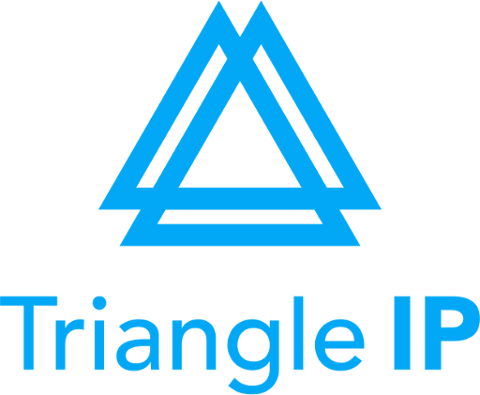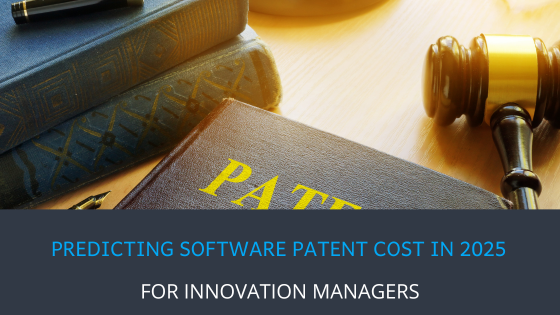How to Predict Software Patent Costs in 2025: A Complete Guide for Innovation Managers
| TL;DR: Software patents in the U.S. cost $30,000–$60,000+ from filing to grant, with extra fees over 20 years. Hidden costs, such as office actions, continuations, or IPR defense, add up. Smart budgeting, expert counsel, and tools like the TIP Tool™ can significantly reduce waste and surprises. |
Securing a patent is hard. But it’s even harder if you try to patent software.
Unlike other inventions, novel code alone doesn’t make software patentable. Many applications with original code fail under section 101 and are ultimately abandoned. Even those that pass face multiple rounds of examination, each costing thousands in attorney fees.
Software patents also face higher scrutiny post-grant, often becoming targets of Inter Partes Review (IPR). That means they must be drafted with litigation in mind, adding to the complexity and cost.
The biggest challenge isn’t just the price; it’s the lack of visibility.
Most innovation managers don’t have a centralized view of patent expenses. Legal and product teams operate in silos. As a result, maintenance fees get missed. Office actions, RCEs( Request for Continued Examination), and continuations catch teams off guard.
Without precise forecasting, even a small software portfolio can bleed patent budgets or stall the patent process entirely.
| 📌Inter Partes Review (IPR) is a USPTO trial process where a third party can challenge the validity of one or more claims in an issued patent, based only on prior art patents or printed publications, under grounds of novelty or obviousness. It is conducted by the Patent Trial and Appeal Board (PTAB) 📌 Request for Continued Examination (RCE) is a written request and fee filed with the USPTO to reopen the prosecution of a patent application after a final office action. It allows the applicant to submit new arguments or claim amendments and continue the examination instead of abandoning or appealing the application |
Understanding the US Patent Path
To understand the complete extent of the cost of a software patent in the US, you need to start by understanding the basics of the USPTO Patent path.
Most software patents in the US begin as either a provisional or a non-provisional application. These are two very different starting points.
A provisional application is a placeholder. It gives you a priority date and 12 months to decide whether to proceed with a complete patent. The filing fee is low—around $140 if your company qualifies as a “small entity”. That’s a fraction of what a full patent costs, which is why many startups begin this way.
However, within a year, you’ll need to file a non-provisional application, which is the formal document the USPTO(The United States Patent and Trademark Office) examines. This stage brings the actual fees for filing, search, and examination. Even with small entity discounts, expect to pay around $800 in government fees at this point. For larger entities, it’s closer to $2,000.
These numbers might seem manageable, but they’re only the surface. Before we dive into the details, here is a quick summary of the total cost breakdown when applying for patents in the USA:
| Cost Category | Type of Expense | Estimated Cost Range |
| Legal | Patentability Search | $1000 – $3000 |
| Drafting | $10,000 – $20,000 | |
| Prosecution | $ 6000 – $20,000 | |
| USPTO Filing Fee | $ 800 – $2000 | |
| The Grant Stage and Beyond | Issuance and Allowance | $1000 – $2000 |
| Maintenance (20 years total) | $6000 – $14,000+ | |
| Optional Cost | Request For Continued Examination | $600 – $1500 |
| Prioritized Examination | $2000 – $4500+ | |
| Appeal | $1300 – $3200+ | |
| Continuation | $2700 – $4000 |
The Legal Costs
Attorney fees are often the largest line item in your patent budget, and for good reason. Drafting a well-written, technically sound software patent requires a skilled patent attorney who can understand your codebase, extract innovative concepts, and translate them into a legally defensible asset. Expect to spend between $10,000 and $20,000 on this initial drafting process. More complex inventions or contributions from multiple inventors can easily push that number higher.
But before you even start drafting, a professional patentability search is a critical first step. This search uncovers existing patents and publications that could render your invention unpatentable. Done right, it saves you from spending tens of thousands on a filing destined for rejection. A comprehensive patentability search typically costs between $1,000 and $3,000, depending on the complexity of the technology. Consider it your first layer of risk mitigation.
Then comes prosecution—the back-and-forth negotiation with the USPTO. The agency rarely grants software patents without at least one round of review, called office actions. Each response can involve claim revisions, legal argumentation, and sometimes interviews with examiners. These rounds of prosecution add up fast. You’ll face at least 2 to 3 office actions, with each response costing between $2,000 and $6,000, depending on the complexity. That brings your total prosecution costs into the $6,000 to $20,000 range.
So, while the official USPTO filing fee may be under $1,000, the real-world cost of a solid U.S. software patent, once you include legal work and prior art analysis, typically lands between $17,000 and $43,000, and it can go much higher. Prosecution delays, examiner pushback, or filing continuations can easily add thousands more.
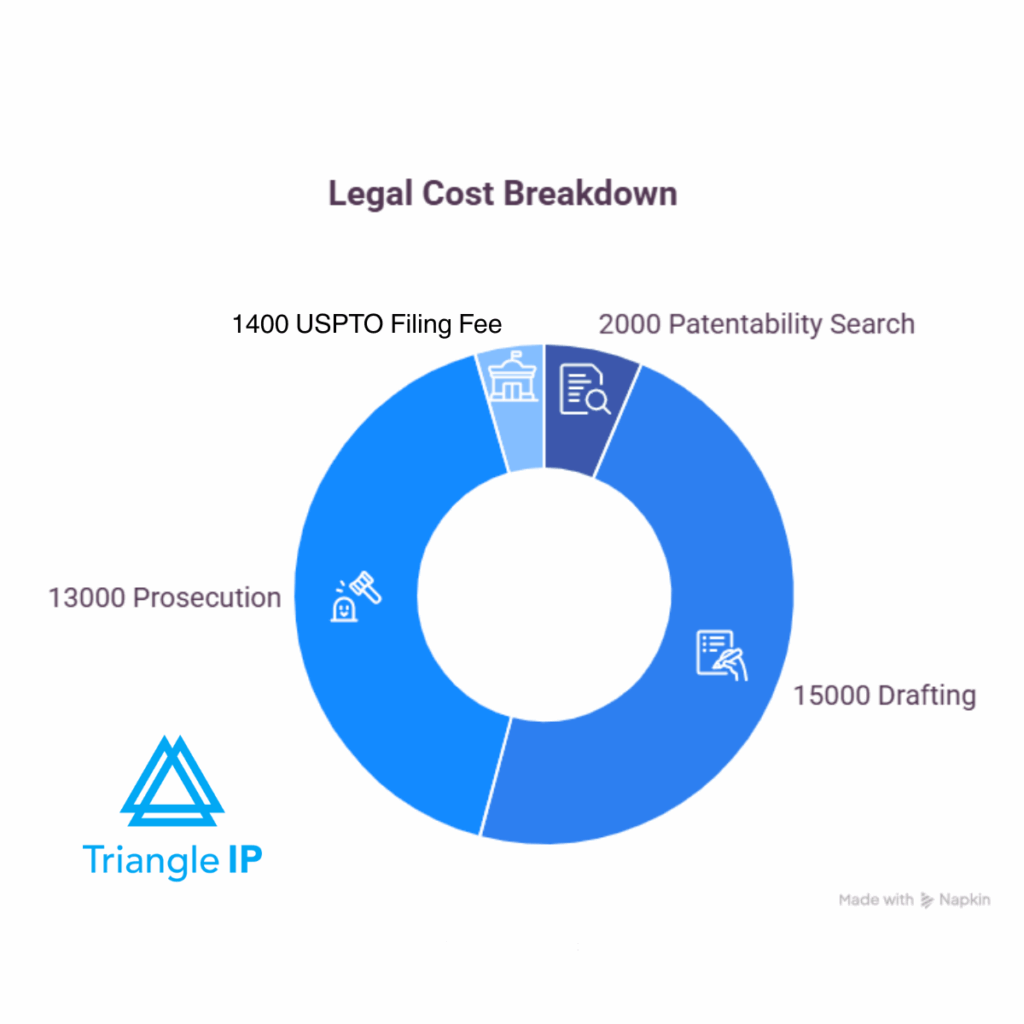
The 2025 USPTO Fee Schedule Just Dropped. Here’s what it means for your next filing.
The Grant Stage and Beyond
Once your application gets approved, you’re not done yet. You’ll need to pay the issue fee to get the patent grant officially. Even here, the cost varies depending on entity size. For most startups (as small entities), the issue fee is a little over $500.
After that, the patent is published and granted, but keeping it alive is another story.
In the U.S., utility patents require maintenance fees at three key intervals: 3.5 years, 7.5 years, and 11.5 years after the patent is issued. These fees go up over time. For small entities, the first payment is around $860. The second is $1,600+. The third climbs to over $3,300. If you qualify as a micro entity, those numbers are even lower, but it still adds up.
Over a 20-year patent lifespan, these maintenance fees can total more than $5,000. Miss a payment, and the patent expires. Paying late adds penalties, and reinstating a lapsed patent is a whole separate process.
The takeaway here is simple: budgeting for a patent means planning for more than a decade of fees, not just a one-time cost at filing.
Optional Costs That Sneak Up
There are also a few optional but sometimes necessary costs that can inflate a software patent’s lifetime cost. One of the most common is the Request for Continued Examination (RCE). If your application is rejected but you believe it can still be approved, an RCE lets you keep the process going. The USPTO charges $600 – $1500( extra if you request a second time), depending on your entity size, and your attorney will charge for preparing the new arguments.
Prioritized examination is an another way to speed up the process. If you need a patent granted quickly, say before a funding round or acquisition, you can pay extra to jump the queue. The fee for this can be nearly $2,000 for a small entity( and $ 4,500+ for a large entity), not including attorney costs. It’s useful in the right scenario but doubles your filing expenses.
If your application is denied outright and you choose to appeal the decision, there are costs involved there, too. The USPTO charges for the notice of appeal ($1300 – $3200+), and your legal fees will rise again. Most innovation managers don’t plan for appeals up front, but they should budget a small contingency if they know the invention is borderline or complex.
And finally, there are continuation applications. These are follow-ups you can file to pursue different claim scopes after a patent is granted or allowed. Think of them as versions 2.0 and 3.0 of your original filing. They cost $2700 ( filed after 6 years) on top of standard filing fees. Continuation applications are commonly used in software to broaden protection or keep options open.
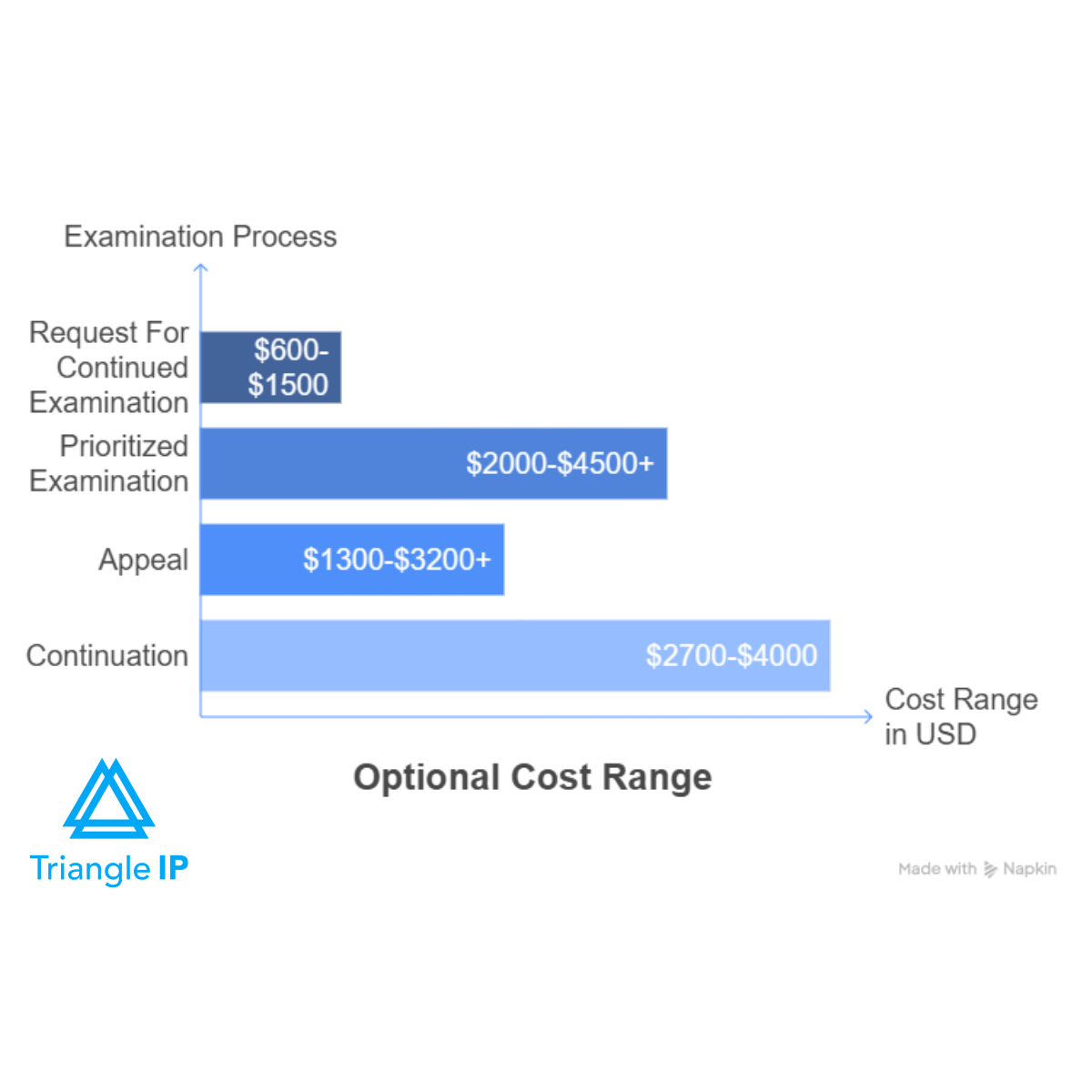
Software Patent Cost While Filing Abroad
If you’re building a product for global markets, a U.S. patent won’t protect you overseas. You’ll need to file in other regions, usually within 12 months of your U.S. application.
Europe is the most expensive region after the U.S. The European Patent Office (EPO) charges high filing and examination fees, and once the patent is granted, you must “validate” it in each country you want protection. That means translation costs, national fees, and annual renewals in multiple countries.
A European software patent can easily cost $25,000 to $50,000 from filing through maintenance. That’s before you’ve even started enforcing it.
India is more affordable, with official fees that are a fraction of what you’d pay in the U.S. or Europe. But legal representation, translations, and maintenance still add up. Budget $7,000 to $15,000 for an Indian patent if you want proper drafting and representation.
One way to buy yourself more time is through the PCT (Patent Cooperation Treaty) process. It doesn’t give you a patent, but it allows you to file once and decide later which countries you want to enter. This gives you up to 30 months to explore the market or raise capital before committing to international costs.
Forecasting the Real Budget
So, how much should you really budget per patent?
For a small or micro entity filing a software patent in the US, a reasonable estimate from filing to grant is $30,000 to $60,000, depending on complexity and legal support. Add another $5,000 to $6,000 over 12 years if you maintain it through its full term.
International filings will at least double that total, and more if you go broad.
This is why experienced innovation managers create multi-year IP budgets—not just for this quarter but for the next 3, 5, and even 10 years. It’s not just about funding the filing. It’s about sustaining the asset long enough for it to deliver value.
How to Reduce Software Patent Cost with The TIP ToolTM
At first thought, it might seem there isn’t much scope for reducing your software patent fees, right? After all, government and patent counsel fees are beyond your control, and you need to pay anyway.
However, there are a few ways you can reduce software patent spending using a patent management tool like the TIP ToolTM.
Steer Away from Difficult Art Units
Art units are organizational divisions within the United States Patent and Trademark Office (USPTO) that group patent examiners by area of technology. Each art unit handles applications related to a particular technical subject matter,
Some art units are, by default, more likely to reject ideas. Rejection means a lower overall chance of approval and added costs to support extra argument rounds.
The TIP ToolTM Advantage
The TIP ToolTM offers the Art Unit Predictor in Triangle IP’s platform. It analyzes your draft claims and predicts which art unit they are likely to be assigned to. If the prediction shows a tough unit, your attorney can adjust the claim language to shift it toward a more favorable one. It can potentially save thousands of dollars in prosecution.

Understand Your Examiner and Calibrate Your Strategy
Getting the right art unit isn’t enough. Assigned examiners also play a critical role in determining your software patentability.
Some examiners have strict internal criteria, and they reject patent applications at a higher rate than average. On the other hand, some examiners are lenient– they respond well to interviews and generally have a much higher acceptance rate.
Once your patent application is assigned to an examiner, don’t go in blind. You or your attorney must strategize based on that examiner’s history and preference. For that, you need solid information about the examiner, which you can get from the TIP ToolTM.
The TIP ToolTM Advantage
The TIP ToolTM offers a feature called “Examiner analysis.” It displays historical data of the examiner along with that particular individual’s personal biases ( approval rate, average approval time, etc.) Based on this information, you can make changes to your plan to suit your assigned examiner.

Have a Comprehensive View of Your Patent Cost to Wisely Plan IP Budget
When you have a clear picture of the exact patent-related costs you have to bear, allocating the budget and financial planning becomes easier. For instance, you can take a call if you want to file a provisional application to buy time to pivot your software capabilities or before a funding round. Or you can decide to abandon a not-so-valuable patent instead of paying for it just because you find a reminder in your inbox.
Long story short, a comprehensive cost prediction can indirectly help improve patent investment ROI and defend your decisions before the C-suite.
The TIP ToolTM Advantage
Click on any patent entries listed under the “patent portfolio” tab on the TIP ToolTM; you will have a pop-up that presents all the information available on that patent, including a detailed estimated cost breakdown. It encompasses almost all relevant costs, including drafting fees, argument round fees, issuance costs, RCE costs, and maintenance fees.
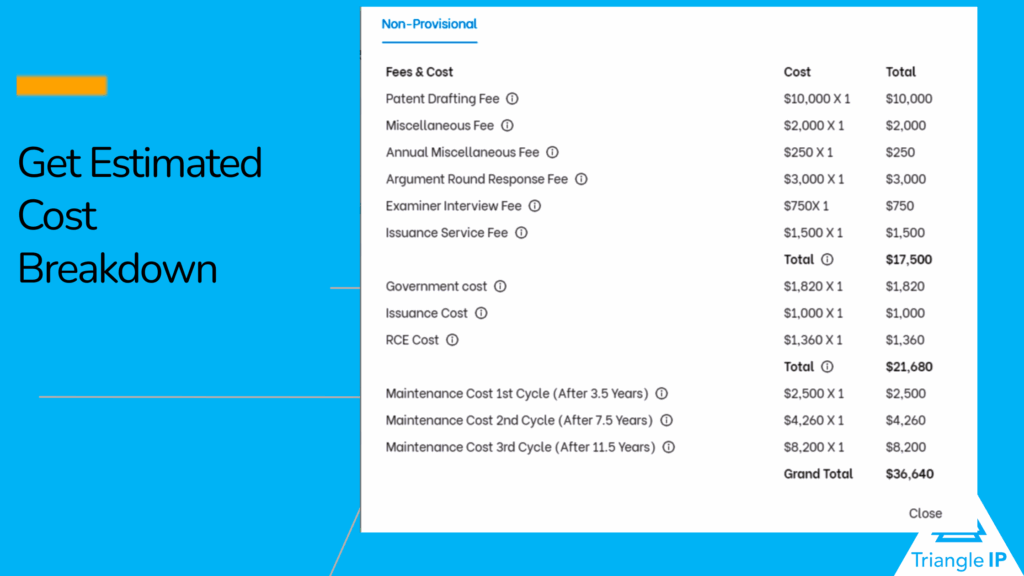
Please note that this software syncs with the USPTO. Therefore, these predictions are based on the latest USPTO fee schedule and are, hence, pretty accurate.
On top of these, the TIP Tool™ comes packed with powerful features, including intuitive idea generation and submission, art unit prediction, examiner insights, idea management, cross-team collaboration, and much more.
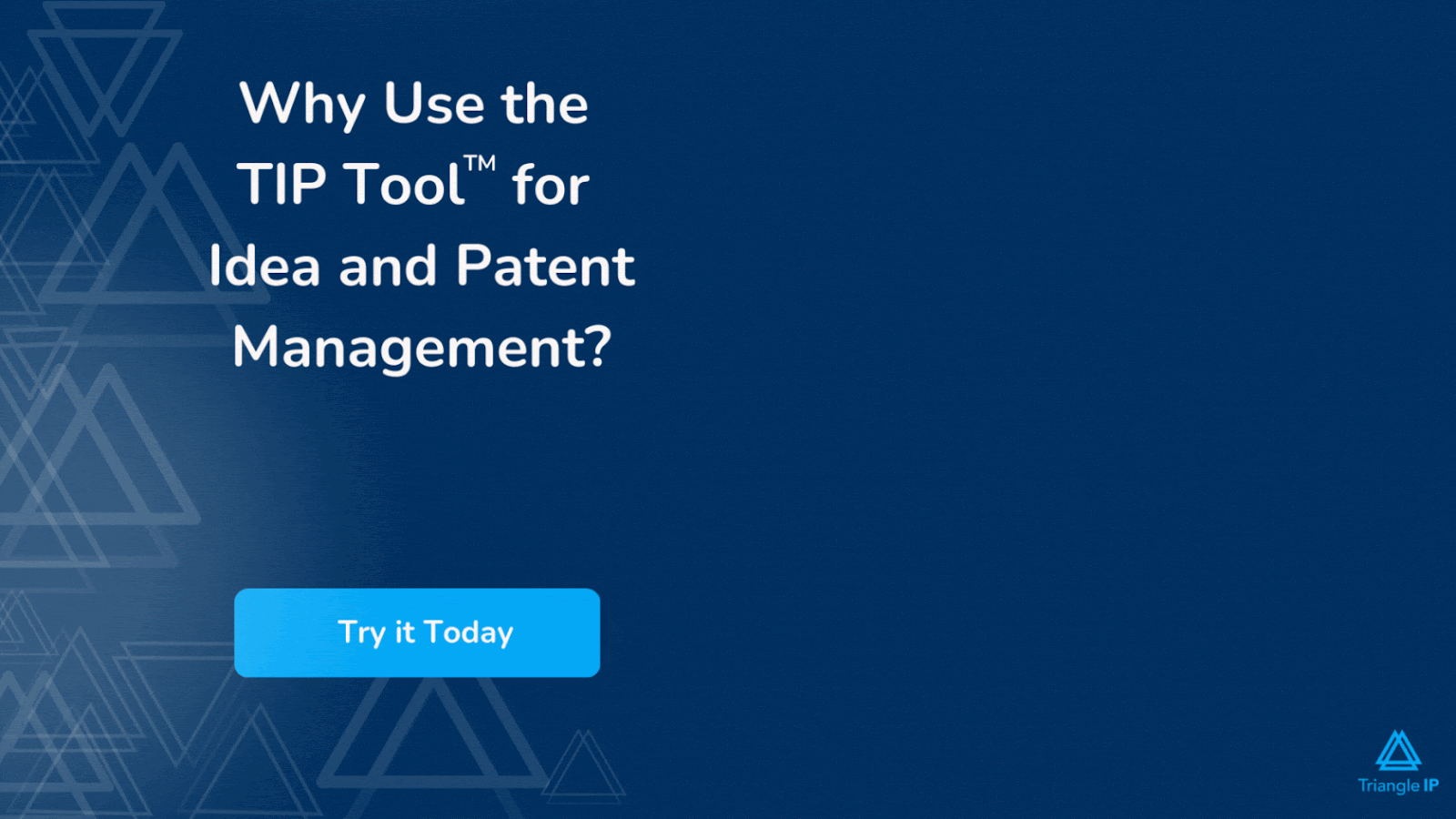
You can sign up here and try the software on your own.
Disclaimer: The information in this article/review is sourced from the internet and may not be entirely accurate or up-to-date. We recommend visiting the respective websites for the most current and reliable information. The opinions expressed here are those of the author and may not reflect the views of Triangle IP. We are not liable for any consequences that may arise from relying on the information provided in this article/review.
FAQ
Is it Better to File a Patent Before or After Launching the Product?
Many assume you need a working product before filing a patent, but the reverse is often better. Filing before launch helps you avoid public disclosure risks that can hurt patent eligibility. That said, filing too early without a clear technical description can lead to weak claims. The ideal time is once your technical solution is stable, even if the product hasn’t gone public yet.
Can One Patent Cover Multiple Related Software Features, or Do I Need to File Separately?
You might assume one patent can protect a whole product, but that’s rarely the case in software. If your features solve distinct technical problems, they may need separate claims—or even separate filings. Combining too much into one application can lead to rejections or narrow coverage. A careful claim strategy can sometimes cover variations, but there are limits.
Do I Still Need a Patent if My Code is Proprietary and Not Visible To Users?
Many believe that hidden or server-side code is safe without patent protection. But if the core idea drives your product’s value or offers a competitive edge, relying on trade secrets alone is risky. A competitor could independently build a similar system or patent it first. Patents offer enforcement power that trade secrets don’t, especially if you scale.
Why Does Predicting Software Patent Costs Matter?
Patent costs ripple into your product timeline, funding strategy, and investor conversations. Without a clear forecast, you risk filing too many patents too soon and burning through budget, or filing too few and leaving key innovations exposed. Predicting costs helps you prioritize what to file, when to file, and how to explain your IP roadmap to leadership. It also keeps you from getting blindsided by surprise fees like maintenance payments or office actions. The bottom line is: when you treat patents as long-term assets, cost visibility is non-negotiable.
When Is It Actually Worth Patenting a Software Invention?
It’s worth pursuing a patent when your software solves a real technical problem and it ties directly to your core product, revenue stream, or market position. You’re in good shape if the invention improves system performance, adds technical depth to your platform, or could create barriers to entry for competitors.
